Flying from Jogjakarta into Soekarno-Hatta Airport in Jakarta provided some good views of the northern sections of the city--old fishing ports, new high rises, much needed toll roads, crowded old neighborhoods and upscale new housing complexes.
Saturday night in Jakarta I enjoyed dinner with my first mission companion Gary Stephens and is wife Louise, They are currently serving as senior missionaries supervising Church humanitarian work in Indonesia and East Timor. We had a great visit but failed to take a photo together.
Sunday morning we attended the Bogor 2nd ward. It is always a happy reunion meeting members including some I have know for over 45 years. The new addition to the chapel in impressive.
After church and lunch we enjoyed a two hour stroll through the lovely botanical gardens. The building is currently a presidential palace and back in the day it was the home of the Dutch governor general.
We watched this monitor swim across the pond and up onto a lily pad with a koi in its mouth.
Monday was our trip to Krakatau. Tuesday we had planned to visit Taman Mini, but found out just the day before that it was still closed for COVID. That then freed up our morning to stop by the Immigration Office in South Jakarta hoping to get an extension for a 30 day visa on arrival. We were first told that anyone in short pants would not be served, then we were told that since our hotel was in north Jakarta we would have to go to the north Jakarta immigration office.
We then visited an obscure place I've long known about but never visited--Lubang Buaya (crododile hole). In 1965 coup, the bodies of seven generals killed in an attempt to bring down the Sukarno government or at least weaken one contingent within the military were deposed of in a deep well.
The crocodile hole.
Suharto, one general not killed in the coup, then stepped in to secure government sites, and to eventually become president when Sukarno (who has communist, China sympathies) stepped down. What followed was a mass anit-communist pogrom that led to the death of as many as 1 million communists, communists sympathizers and accused people (perhaps a rival or unkind neighbor) who may have had not links to the PKI (Indonesian Communist Party). This panel shows a trial for communist participants and leaders.
Following a student presentation on the coup we had a lively discussion about who might have actually been behind the coup. For a long time it was pinned solely on the PKI--perhaps with Sukarno's backing, but then evidence has also pointed to the CIA which may have wanted a more pro-western leader (Suhartao) to work with, or to a conflict within competing factions of the military and government .
We then toured a museum full of dioramas that lay out the lead up to the coup, the massacre of the general, and the anti-communist fallout. Almost all of the displays pin any conflict or problem during the first two decades of Indonesia on the PKI, even it was just a labor strike or a local political problem.
There are dioramas for each of the generals, one aid and one little girl killed in the September 30 coup.
After our lesson on the evils of communism, we had lunch at one of Jakarta's many swanky malls where everyone found something they liked to eat.
Evening views from the roof top of our hotel.
Next morning we arrived at the Central Jakarta immigration office just before it opened at 8:00. This time we all wore long pants.

We came equipped with filled out forms (picked up the day before), photo copies of our passport and visa, and 500,000 rupiah each, We then learned that we also needed to filled out an introduction letter with an affixed special stamp purchased in the small post office four stories down, that we needed to print out proof of our return flight plans--printed out in the copy kiosk four stories down, and that we would then need to wait five days! Ben Marr, one of our students who had served a mission in Indonesia and had worked in the mission office where procuring visas were also a problem, helped out a lot and convinced the nice clerk to speed things up because we were flying to Aceh in two days and we had plans for the next day. She agreed to have them ready the next day by noon and allowed us to do the next steps of getting figure printed and photographed. The whole ordeal took four hour. While Ben and I, plus other returned missionary who served in Indonesia Mckay Treadwell did most of the running around and interfacing. The rest of the group enjoyed a quiet morning of good wifi and AC.

We enjoyed lunch in the old Dutch post office (where I would mail missionary letters home) now turned into a cool collection of shops and eateries.
We walked past the Dutch Catholic Cathedral and the Istiqlal mosque across the street and used them as a visual example in the urban landscape of religious tolerance in Indonesia.
Going inside the large beautiful mosque was part of our plan, but we found out on arrival that it was still closed for COVID.
We knew going to the top of Monas (National Monument) and its basement historical museum (more diorams) were closed, but I didn;' think that wide open spaces of the surrounding Merdeka (Independence) Square would also be gated shut.
We walked the northern perimeter past the Presidents house
We were allowed to briefly slip the NE gate to take this group photo.
We then spent two hours exploring the national museum, which had all kinds of impressive displays that illustrate Indonesia's location in a shatterbelt that has long been influenced by the migrations of different peoples and religions and how its large, fragmented territory is home to a fascinating mosaic of peoples, cultures, textiles, music, architecture, and material culture.
Puppets of the Angel Michael, Jesus Mary and Joseph.
My friend Suprodjo who I met at USU and whose family in Jogja remain my good friends, once told me back in our USU days that Islam was propagated in Indonesia in part by teaching about Islam via traditional puppets (wayang). Suprodjo then suggested that Mormon missionaries might want to use a similar technique and make wayang puppets (wood or buffalo hide) to tell the Joseph Smith story. I thought it was a great idea.
Walking back to our hotel we passed this large mid-road statue with Rama in the chariot on the southwest corner of Merdeka Square.
Hotel Indonesia. The right wing was one of only a few international hotels in the 1970s. Now they are everywhere and much taller.
Badminton is big in Indonesia.
Happy to find some delicious not-in-season Manggis to enjoy.
Two evenings Will and I enjoyed dinner with BYU alumni and friends. Hanna Sihab (in the jilbab) is from a prominent Arab-Indonesian family. Her uncle is Alwi Shihab, a good friend of the LDS Church. She studied communications at BYU and is now an adjunct professor at the University of Indonesia. Years ago when I was in Jakarta she helped me select all of the readings I used when I taught the Indonesian 330 class. The other night Iksan and his son Ilham (who studies GIS and UI) also met us for dinner. Iksan's wife Rumtini earned her PHD in Education from BYU. Iksan has helped me find data for a map I'm having made showing the distribution of Christians in Indonesia.
For our last day in Jakarta, we rode a commuter train north to the old Dutch center of town.
The Governor-General's palace is now an interesting museum on the history of Jakarta.
Solomon determining the rightful of two claimant mothers.
A basement dungeon. Executions were held on the platform in the front.
While the students walked along a large Dutch built canal and toured the museum of sailing and the spice trade, Ben and I returned to immigration where we were able to pick up all 13 passports with new visas stamps. We then joined the group in food court in a mall in the heart of Glodok--Chinatown.
A Catholic Church in the style of a Chinese temple.
The Chinese Buddhist Temple complex of Jin De Yuan. The newer main temple which lined with all sorts of deities that can help with all sorts of concerns.
The oldest Chinese Temple in Jakarta.
Photos of Chinese temples across Java
Outside the temple complex we had a presentation on the 1998 economic crisis and the subsequent attack on the Chinese community of Indonesia. In Glodok that year Chines homes and businesses were attacked and burned, people were killed and women were pulled out of cars and raped.
Walking through Glodok seemed not much different from 45 years ago.












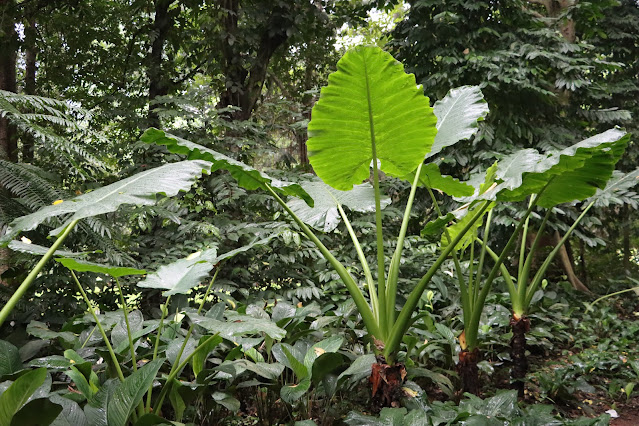
















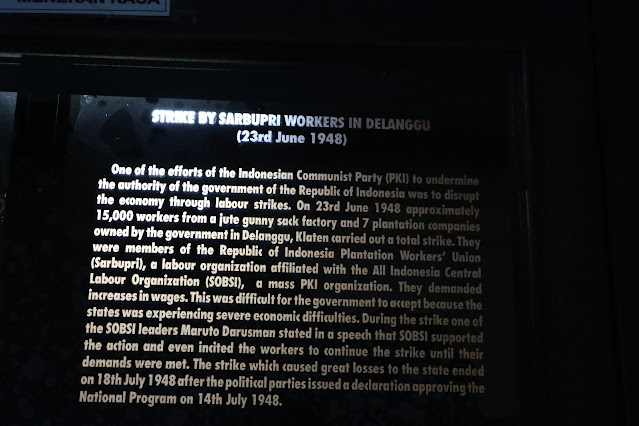














































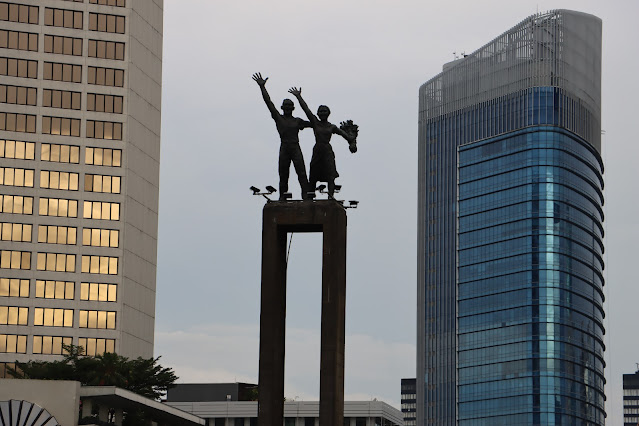








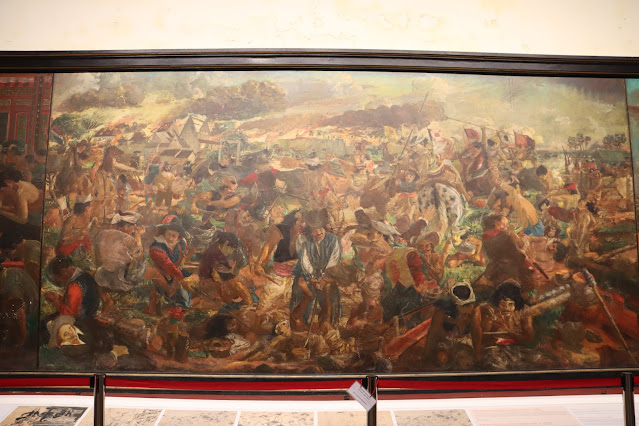







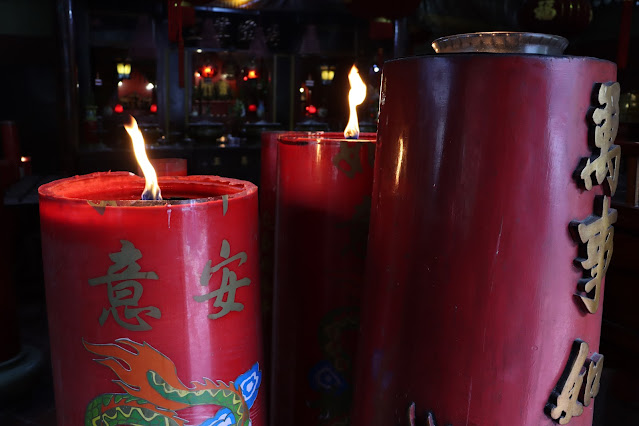









No comments:
Post a Comment